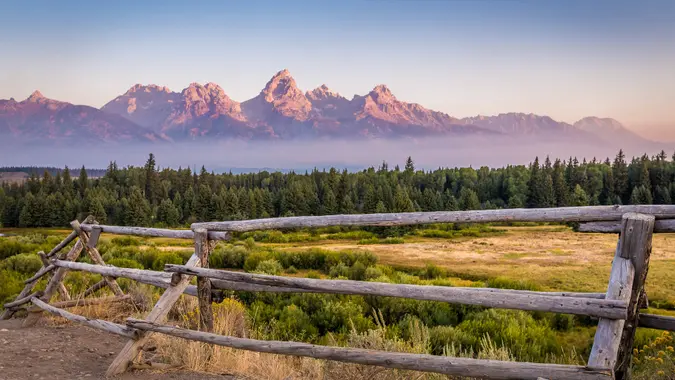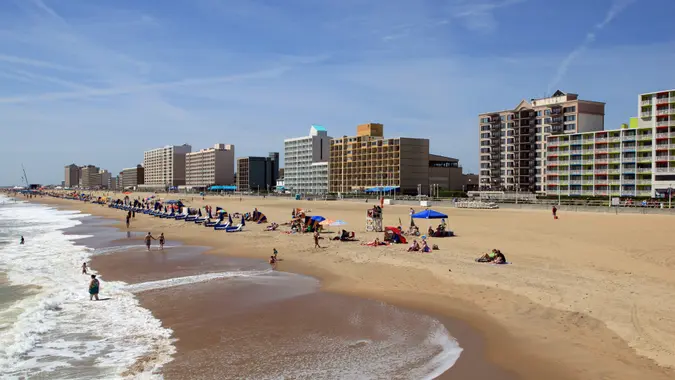Nomadic Retirement: How to Retire and Travel the World on Your Terms

Commitment to Our Readers
GOBankingRates' editorial team is committed to bringing you unbiased reviews and information. We use data-driven methodologies to evaluate financial products and services - our reviews and ratings are not influenced by advertisers. You can read more about our editorial guidelines and our products and services review methodology.

20 Years
Helping You Live Richer

Reviewed
by Experts

Trusted by
Millions of Readers
Nomadic retirement means giving up a permanent home to live and travel full-time, moving from place to place instead of settling in one spot. For many retirees, it’s a lifestyle that combines freedom, adventure, and the potential for lower living costs abroad or in different parts of the U.S.
Living as a nomad requires more than wanderlust — it takes careful planning, flexible budgeting, and a willingness to adapt to life on the move. Yet for those who crave new experiences and the ability to live where life feels richest, nomadic retirement can be deeply rewarding.
This guide breaks down what the lifestyle involves, how much it costs, key considerations like healthcare and residency, and practical tips for planning a sustainable, globe-trotting retirement.
What Is a Nomadic Retirement?
Nomadic retirement is a lifestyle where retirees give up a permanent home and choose to live on the move — traveling between cities, states, or even countries for extended stays instead of settling in one place. It’s about trading stability for freedom, turning retirement into an open-ended adventure rather than a fixed destination.
This lifestyle offers appealing advantages, such as flexible schedules, immersion in new cultures, and the ability to follow good weather or favorable exchange rates. Because it often means selling a home or ending a lease, nomadic retirement can also reduce one of the biggest costs most retirees face — housing.
But constant travel comes with trade-offs. Without a fixed base, retirees must navigate frequent planning, changing logistics, and inconsistent access to healthcare. Nomadic retirement can be deeply rewarding, but it requires careful budgeting, adaptability, and a genuine love of life on the move.
How Much Does a Nomadic Retirement Cost?
According to the Bureau of Labor Statistics (BLS), the average retiree spends about $4,345 per month, and Western Financial estimates that roughly $1,787 of that goes toward housing and related costs. Those expenses can include mortgage payments, property taxes, insurance, HOA fees, repairs and maintenance, or — for renters — monthly rent that covers many of those same costs.
Without that housing burden, retirees who embrace a nomadic lifestyle can often spend less on lodging than they would maintaining a home. However, costs can vary widely depending on travel style, destination choices, mode of transportation, seasonality, and how often they move.
For real-world insight, The Mobile Retiree, a resource created by and for “senior nomads” and expats, publishes detailed cost-of-living reports based on firsthand experiences. While anecdotal, its data offers a valuable window into how much a comfortable, budget-conscious nomadic lifestyle can actually cost.
Real Costs of Nomadic Retirement Around the World
Nomadic retirees can find comfortable and affordable living options across the globe, with total monthly expenses often coming in far below what they might spend at home. While housing is typically the biggest cost, the total price tag varies by location, travel pace, and accommodation type. Here’s a snapshot of real-world expenses reported by long-term travelers:
Buenos Aires, Argentina
- Total cost: $2,700 per month for two months ($5,400 total)
- Housing: $1,766 for two months
Durrës, Albania
- Total cost: $5,065 for 61 days
- Housing: $1,458 total (about $24 per night)
Chile
- Total cost: $3,688 for six weeks
- Housing: $1,488 total
Housing, of course, is just one part of the equation. Other key expenses — including food, health insurance, medical care, and transportation — can add up quickly depending on travel style and destination. These categories are explored in more detail further down the page.
Best Destinations for Nomadic Retirees
Nomadic retirees don’t have to go abroad to embrace the lifestyle — many find adventure and affordability right in the U.S. Seasonal rentals, extended-stay hotels, and RV parks allow travelers to chase good weather, explore national parks, and enjoy communities of like-minded retirees across the country. States like Arizona, Florida, and New Mexico are especially popular for their sunshine, lower living costs, and large snowbird networks.
For those seeking international experiences, the options expand dramatically. Living overseas can stretch your retirement income further while offering cultural richness and a slower pace of life. However, retirees should carefully consider visa requirements, healthcare access, safety, language barriers, and political stability before choosing a destination.
Below are several countries that consistently attract nomadic and retired travelers for their affordability, livability, and established expat communities:
- Portugal. Beloved for its mild climate, coastal beauty, and friendly locals, Portugal offers affordable healthcare and a variety of long-stay visa options.
- Thailand. Known for its warm hospitality, world-class cuisine, and low cost of living, Thailand remains a top pick for retirees who value comfort and affordability.
- Mexico. Proximity to the U.S., vibrant culture, and diverse climates make Mexico an easy and cost-effective choice for part- or full-time living abroad.
- Chile. Offers modern infrastructure, political stability, and diverse landscapes — from the Atacama Desert to Patagonian peaks — all at a reasonable cost.
- Latvia. A lesser-known gem in Europe, Latvia combines historic charm, affordable housing, and access to the broader Schengen Area.
- Spain. With its Mediterranean climate, excellent healthcare system, and relaxed pace of life, Spain remains one of Europe’s most retiree-friendly destinations.
- Uruguay. Stable, peaceful, and socially progressive, Uruguay offers a temperate climate, strong healthcare, and a welcoming expat community.
Whether you stay stateside or go global, the key to a successful nomadic retirement is balancing wanderlust with practical planning — from budgeting and healthcare to residency rules and safety.
Housing Options for Nomadic Retirement
NHousing is the biggest variable in a nomadic retirement budget — and also where retirees have the most control. The right setup depends on how often you plan to move, your desired level of comfort, and how much flexibility you want. Many retirees even combine options throughout the year to balance cost, convenience, and experience.
Common approaches include:
- Full-time RV living. Ideal for retirees who want complete mobility while staying within the U.S. or Canada. RV life offers freedom and community but requires maintenance, fuel costs, and familiarity with campgrounds or RV parks.
- Short-term rentals. Staying in Airbnbs, vacation homes, or furnished apartments allows retirees to experience new places without long-term commitments. It’s flexible, but nightly or monthly costs can fluctuate based on season and location.
- Seasonal rentals. Perfect for “slow travel,” seasonal rentals let retirees settle in one place for several months at a time, often at discounted monthly rates.
- International rentals. Renting abroad, especially in regions with lower costs of living, can make a fixed retirement income go further. Many retirees rotate between countries with established expat communities and reliable healthcare systems.
- House-sitting. A cost-effective choice for retirees who enjoy caring for homes or pets while traveling. It can dramatically reduce lodging costs and provide a sense of home, though it limits flexibility in destinations and timing.
Some nomadic retirees choose to sell their primary home to fund their travels, while others rent it out for ongoing income and a backup plan should they decide to settle down again. Each choice has its trade-offs — selling frees up equity but eliminates a safety net, while renting maintains an asset but adds management responsibilities.
Staying Healthy on the Move: Healthcare and Insurance for Nomadic Retirees
Healthcare is one of the most important — and often most overlooked — parts of planning a nomadic retirement. Medicare provides coverage across all 50 states, but it generally does not extend outside the U.S. If you travel domestically, it’s essential to understand your plan’s network rules and whether you’ll need supplemental coverage when moving between regions.
For retirees spending time abroad, traditional Medicare won’t be enough. You’ll need travel medical insurance, which typically costs around $150 per month for basic coverage and more for comprehensive or long-term international plans. These policies can cover emergencies, hospital stays, and medical evacuations — crucial protection when living overseas.
To maintain continuity of care, many nomadic retirees rely on telehealth appointments with U.S. providers and set up systems for managing prescriptions abroad. Some even choose destinations known for affordable, high-quality healthcare to help control costs while staying protected.
What It Takes to Fund a Nomadic Lifestyle
A successful nomadic retirement isn’t just about where you’ll go — it’s about how you’ll pay for it. Financial stability is the backbone of this lifestyle, and careful planning helps ensure your travels remain sustainable for the long term.
Key steps include:
- Creating a realistic budget that accounts for all expected expenses — from lodging, transportation, and healthcare to travel insurance and periodic trips home.
- Building an emergency fund to handle unexpected medical costs, flight cancellations, or family emergencies without derailing your plans.
- Managing banking and currency efficiently, such as using low- or no-foreign-transaction-fee credit cards, digital banks, and secure online payment systems.
- Factoring in investments and Social Security to ensure you have a steady income stream that can support your travel pace and cost of living.
- Planning for taxes if you’ll be earning, investing, or maintaining a home base across multiple states or countries.
With the right strategy, your finances can give you the freedom to focus on what matters most — enjoying the journey.
What a Nomadic Retirement Budget Might Look Like
Before selling your home or booking that one-way ticket, it’s essential to understand what day-to-day life might actually cost. While expenses vary widely depending on your travel style, destination choices, and pace of movement, a realistic monthly budget can help you see whether a nomadic lifestyle fits within your retirement income.
The example below shows a sample monthly budget for a moderate-paced nomadic retirement, based on common expenses reported by full-time travelers.
| Expense category | Estimated monthly cost |
|---|---|
| Housing (Airbnb or short-term rental) | $1,000 – $1,500 |
| Travel (flights, local transport) | $500 – $1,000 |
| Food and dining | $400 – $600 |
| Insurance and healthcare | $200 – $400 |
| Miscellaneous (activities, SIM card, supplies, etc.) | $300 – $500 |
That brings the total to roughly $2,400 to $4,000 per month — significantly less than the $4,345 average monthly spending for U.S. retirees reported by the Bureau of Labor Statistics.
Your own numbers will depend on how and where you travel. Slow travel (staying in one place longer) and off-season rentals can keep costs lower, while frequent flights, premium accommodations, and international insurance plans will push your budget higher.
How to Stay Connected and Safe While You Travel
A nomadic lifestyle offers freedom, but it can also create distance from family, friends, and familiar routines. Staying connected helps maintain a sense of community and emotional well-being, no matter where your travels take you.
Here are a few ways to stay engaged and reachable while on the move:
- Manage your mail: Set up digital mail forwarding services so you can view important correspondence from anywhere.
- Stay in touch regularly: Use text or email threads to share updates and photos, or schedule recurring video calls with loved ones.
- Leverage social media and messaging apps: Tools like WhatsApp, Signal, or Facebook Messenger make it easy (and free) to communicate internationally.
- Stay digitally connected: Invest in reliable Wi-Fi hotspots, local SIM cards, or a VPN to keep your devices secure and online wherever you go.
Safety should always be part of your routine, too. Keep valuables secured, learn local customs and emergency numbers, and research neighborhoods before you arrive. Being connected — both socially and technologically — helps ensure your travels stay enjoyable and safe.
Pros and Cons of Nomadic Retirement
Before committing to a life on the move, it’s important to weigh the rewards and realities of a nomadic retirement. The lifestyle offers undeniable freedom — but it also comes with practical and emotional trade-offs.
Pros
- Flexibility. You decide where to live, how long to stay, and what pace to travel at.
- Adventure. Every new destination brings fresh experiences and discoveries.
- Cultural enrichment. Living among locals offers a deeper understanding of different ways of life.
- New connections. Fellow travelers and expat communities can provide friendship and support along the way.
- Potential cost savings. In some regions, the cost of living is far lower than maintaining a permanent home in the U.S.
Cons
- Constant planning. Coordinating travel, visas, and lodging can feel like a part-time job.
- Potential loneliness. Being far from family and longtime friends can take an emotional toll.
- Disconnection from community. Without a fixed base, it takes effort to build meaningful local ties.
- Healthcare challenges. Accessing care abroad or between states requires foresight and flexibility.
- Travel fatigue. Even the most seasoned nomads sometimes crave rest and routine.
Is a Nomadic Retirement Right for You?
A nomadic retirement can be deeply fulfilling — or overwhelming — depending on your personality, health, and financial comfort. It’s best suited to those who value freedom over familiarity, are adaptable in the face of uncertainty, and find joy in new surroundings rather than permanence.
Before taking the leap, test the waters. Try extended stays in different cities, rent out your home short-term, or spend a few months traveling with a plan to return. You’ll quickly learn what feels exciting — and what feels exhausting.
For some, the best part of retirement is finally staying put. For others, it’s discovering that “home” can be anywhere in the world.
FAQ
- How do retirees afford to travel full time?
- Many retirees make full-time travel possible by selling their homes or ending rental leases, freeing up one of their biggest monthly expenses. Careful budgeting, advance planning, and thoughtful spending — especially on housing and transportation — make the lifestyle more sustainable over time.
- Is nomadic retirement realistic on Social Security alone?
- It can be, depending on where and how you travel. The average Social Security benefit is about $2,000 a month, which aligns with the lower end of a modest nomadic budget. Retirees who choose low-cost destinations and travel slowly can often make it work, though having savings or additional income provides more flexibility.
- What happens if you get sick or injured while abroad?
- Since Medicare doesn’t cover care outside the U.S., travel medical insurance is essential. It covers unexpected illnesses or injuries while abroad and may include emergency evacuation. Before traveling, research the local healthcare system, know where to find English-speaking doctors, and contact the nearest U.S. embassy or consulate if you need help arranging care.
- Can you return to a traditional retirement later?
- Yes. Many retirees spend a few years on the road before deciding to settle down again. As long as your finances allow — whether through savings, home equity, or rental income — you can transition back to a more traditional, residence-based retirement whenever you choose.
- How do you handle taxes and residency issues?
- U.S. citizens remain subject to U.S. taxes no matter where they live. That means filing an annual return and reporting any foreign income, bank accounts, or gifts. Depending on your travel pattern, you may also need to navigate local tax rules abroad or state residency rules at home. Consulting a tax professional with experience in expatriate or multi-state filings can help you stay compliant and avoid surprises.
 Written by
Written by  Edited by
Edited by 

























